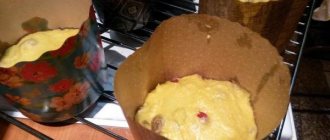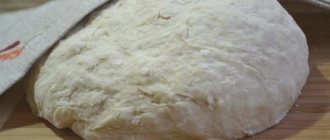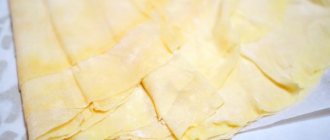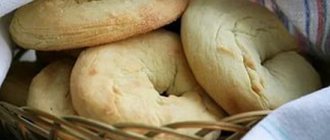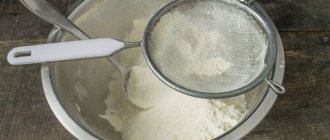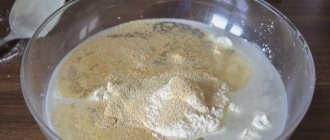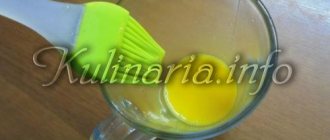There is an opinion that lean dough is something boring, bland and tasteless. However, believe me, this is not the case. Yes, it is prepared without eggs and milk, gelatin and butter. But it’s quite possible to do without these ingredients and prepare something so delicious that you’ll lick your fingers.
Therefore, if you observe the Orthodox Lent, then today’s selection of recipes for various versions of Lenten dough will come in handy for you. By the way, this base for pizza or dumplings can be used all year round. I am sure that those who watch their weight will appreciate it.
The main ingredient of lean dough is flour. It is usually customary to add premium grade wheat. If you want the prepared dish to be not only tasty, but also healthy, I advise you to use whole grain. Or, alternatively, you can mix it half and half with white wheat. You can also use oatmeal, buckwheat, corn and rice flour.
Another irreplaceable ingredient in the base for pies and buns is water. If you cook without yeast, I recommend using sparkling mineral water. It will saturate the dough with air bubbles. Thanks to this, it will become tender and soft.
Add more vegetable oil. Both refined and unrefined vegetable oil can be used. The choice here is huge: sunflower, corn, olive and so on. If you are preparing savory baked goods, you can use vegetable oil infused with garlic or herbs. This will give the dish an amazing taste. This option is especially good when making flatbreads, such as Italian focaccia.
Well, are you ready to start preparing the Lenten dough? Then catch the 6 best base recipes for dishes and baked goods.
In general, there are several options for the Lenten test. It's flaky, yeasty and bland. The latter is good because it comes up much faster than the butter one. And besides, baked goods made from it do not go stale very quickly. Only for this you need to wrap it in linen or cotton cloth and place it in a plastic bag.
Lenten yeast dough for pies
This dough is prepared using raw yeast. Although, if you don’t have them on hand, you can use dry ones, however, you will need much less of them: only 7 g. Clean drinking water is used to prepare it.
Although, if you wish, you can experiment by making the dough with mineral water or potato broth. Don't be afraid, you won't spoil it.
On the contrary, thanks to such interpretations the dough will be tastier and softer. And before you cook it, stock up on the necessary products.
What you will need:
Preparation:
Heat the water to 35-40 degrees and dissolve the sugar in it. Then add yeast and a little flour, after which we mix everything thoroughly.
Next, cover the bowl with cling film and leave it warm for 10 minutes. During this time, the yeast should be activated. And you and I will be able to check whether they are good or not, which means we will finally determine whether they can be used to prepare dough. The presence of a “cap” on top is a sure sign that the yeast is good and fresh.
Pour the “sourdough starter” into a larger bowl. Next, add salt here and mix gently. After this, add a glass of flour. I advise you to sift it first. This will saturate it with oxygen and thanks to this, the baked goods will become fluffy.
Then mix thoroughly, trying to dissolve the lumps as much as possible. If they still remain, do not be discouraged. They will all dissolve while kneading the dough. Next, cover the container with cling film and leave it warm for half an hour.
At this time, live yeast will actively ferment the dough, helping to ensure that future baked goods are more fluffy.
If the room is cool, pour warm water into a bowl and place the container with the dough in it. This will create the optimal temperature for the dough to rise.
In half an hour the dough will increase several times. Add vegetable oil to it. We also gradually add the remaining sifted flour into the dough and knead it thoroughly.
Sift some flour onto a work surface. Place the dough on it and continue kneading it for 10 minutes. First, lubricate your hands with vegetable oil. As you knead, it will become soft and elastic, and will not stick to your hands.
Next, place the bun in a bowl. Lightly grease the bottom of the bowl with vegetable oil. Cover the top of the container with cling film and leave in a warm place for an hour.
During this time the dough will become airy. Now you can safely roll it out and use it for pies or buns. And it will also be an excellent base for buns.
Lenten choux pastry
Suitable for dumplings.
Ingredients
- 450–500 g flour + a little for sprinkling;
- 300 ml boiling water;
- 1 teaspoon salt;
- 3 tablespoons of vegetable oil.
Preparation
Sift the flour and make a well in it. Add salt and oil to boiling water and stir. Pour the liquid into the well in the flour, stirring thoroughly.
When the mass has cooled down a little, remember it with your hands. Place on a floured counter and knead by hand for about 10 minutes. Place the dough in a bowl, cover with film and leave for half an hour.
Add to favorites
